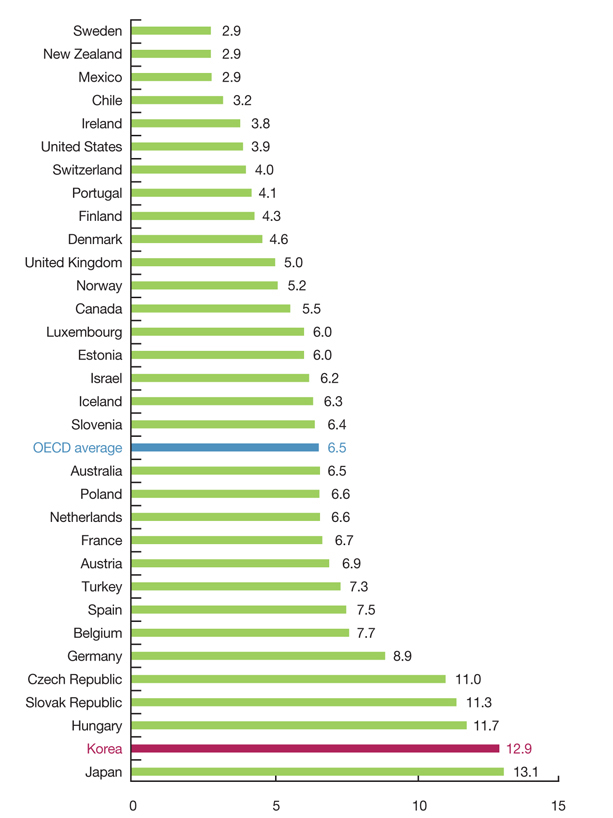Strategies for improvement of primary care in Korea
- Affiliations
-
- 1Department of Health Management & Policy, Kangwon National University School of Medicine, Chuncheon, Korea. joheuisug@gmail.com
- KMID: 2192816
- DOI: http://doi.org/10.5124/jkma.2012.55.10.959
Abstract
- Primary care is essential among the strategies for expansion of healthy life expectancy and quality of life. The purpose of this study was to suggest strategies for improvement of primary care in Korea, in light of the current Korean condition. Data and reports related to primary care and medical were collected and analyzed, applying the structure-process-outcome frame, taking into consideration current medical care delivery system. Current primary care system is considered inappropriate and inefficient from many perspectives. In particular, continuous and comprehensive management of chronic disease is needed. To effectively carry out the function of primary care, an incentive system for patients' and physicians' motivation is needed. Also, support for improvement of the capability to manage patients and monitor health outcomes has to be considered. It is hoped that the government will develop a long-term vision and make ongoing investments.
Keyword
MeSH Terms
Figure
Cited by 4 articles
-
The current status and directions of healthcare policy in Korea
Eun-Cheol Park
J Korean Med Assoc. 2012;55(10):930-931. doi: 10.5124/jkma.2012.55.10.930.Concept, values, current status and prospect of primary care in Korea
Yong-Jun Choi, Byung-Su Ko, Kyung-Hee Cho, Jae-Ho Lee
J Korean Med Assoc. 2013;56(10):856-865. doi: 10.5124/jkma.2013.56.10.856.The direction of reform for enhancing primary care
Jung-Jin Cho
J Korean Med Assoc. 2016;59(7):482-485. doi: 10.5124/jkma.2016.59.7.482.The Utilization of Oral Health Services in Community Health Centers in Korea: A Study Using Data from the 2011-2012 Community Health Survey
Su-Kyung Park, Chun-Bae Kim, Won-Gyun Chung, Yang-Hee Ahn, Nam-Hee Kim
J Korean Acad Oral Health. 2014;38(3):154-164. doi: 10.11149/jkaoh.2014.38.3.154.
Reference
-
1. Donaldson MS. Institute of Medicine, Division of Health Care Services. Primary care: America's health in a new era. 1996. Washington, DC: National Academy Press.2. Starfield B, Shi L, Macinko J. Contribution of primary care to health systems and health. Milbank Q. 2005. 83:457–502.
Article3. Health Evidence Network. World Health Organization. What are the advantages and disadvantages of restructuring a health care system to be more focused on primary care services? 2004. Copenhagen: WHO Regional Office for Europe.4. Choi YJ. Korean Health Policy and Administration. Strategy for primary care for reduction of medical expenditure. Proceedings of the 46th Academic Conference of Korean Health Policy and Administration. 2011. 2011 May 27; Seoul, Korea. Seoul: Korean Health Policy and Administration;91–116.5. Kim J, Kim H, Kim H, Min KW, Park SW, Park IB, Park JH, Baik SH, Son HS, Ahn CW, Oh JY, Lee S, Lee J, Chung CH, Choi KM, Choi I, Kim DJ. Current status of the continuity of ambulatory diabetes care and its impact on health outcomes and medical cost in Korea using national health insurance database. J Korean Diabetes Assoc. 2006. 30:377–387.
Article6. Kim SY, Lee JH, Choi YJ. Korean Academy of Family Medicine. Structural analysis and evidence based mapping for primary care. Proceedings of the Academic Conference of the Korean Academy of Family Medicine. 2008. 2008; Seoul: Korean Academy of Family Medicine.7. Donabedian A. Evaluating the quality of medical care. Milbank Mem Fund Q. 1966. 44:Suppl. 166–206.
Article8. Lee JC. Causes and strategies for crisis of policy of national health insurance system. Healthc Policy Forum. 2012. 10:30–35.9. Park SK. Korean Health Policy and Administration. Vision and prospect for activation of primary care. Proceedings of the 46th Academic Conference of Korean Health Policy and Administration. 2011. 2011 May 27; Seoul, Korea. Seoul: Korean Health Policy and Administration;117–140.10. Organization for Economic Cooperation and Development. OECD reviews of health care quality: Korea 2012 [Internet]. 2012. cited 2012 Sep 25. Paris: Organization for Economic Cooperation and Development;Available from: http://www.oecd-ilibrary.org/social-issues-migration-health/oecd-reviews-of-health-care-quality-korea_9789264173446-en.11. Ministry of Health and Welfare. Report of effectiveness for establishment of healthcare delivery system. 2012. Seoul: Ministry of Health and Welfare.12. Research Institute for Healthcare Policy. Analysis of the OECD health data 2011. 2011. Seoul: Research Institute for Healthcare Policy.13. Oh YH. National health utilization survey: the result of analysis from medical utilization. 2011. Seoul: Ministry of Health and Welfare.14. Korea Centers for Disease Control and Prevention. Community health survey. 2008. Cheongwon: Korea Centers for Disease Control and Prevention.15. Task Force Team for Basic Statistical Study of Korean Diabetes Mellitus. Report of Task Force Team for Basic Statistical Study of Korean Diabetes Mellitus: diabetes in Korea 2007. 2007. 1st ed. Seoul: Goldfishery.16. Research Institute for Healthcare Policy. Report of the medical practitioners' offices in Korea. 2011. Seoul: Research Institute for Healthcare Policy.17. Coleman K, Austin BT, Brach C, Wagner EH. Evidence on the chronic care model in the new millennium. Health Aff (Millwood). 2009. 28:75–85.
Article18. Bae SS, Lee TJ, Choi YJ. A study on analysis of chronic disease management and strategy of developing a nation-wide diffusion. 2008. Seoul: Hallym University, Institute of Social and Preventive Medicine.19. Bae SS, Gang MN, Kim GG, Kim JY, Park NS, Park IB, Shin DS, Jo HS, Choi YJ. Study of cardiovascular and cerebrovascular disease prevention and improved management in Seoul. 2010. Seoul: Hallym University, Institute of Social and Preventive Medicine.
- Full Text Links
- Actions
-
Cited
- CITED
-
- Close
- Share
- Similar articles
-
- Strategies in the management of bronchial asthma for the primary care physician
- Strategies for treatment of geriatric incontinence in primary care
- Development of a Community-based Participatory Global Health Project Model for Primary Health Care Capacity Development: A Case Study from a Rural Community in Ecuador
- Quit smoking strategies in primary care
- Strategies to strengthen primary care for the efficiency and equity of health care in Korea


